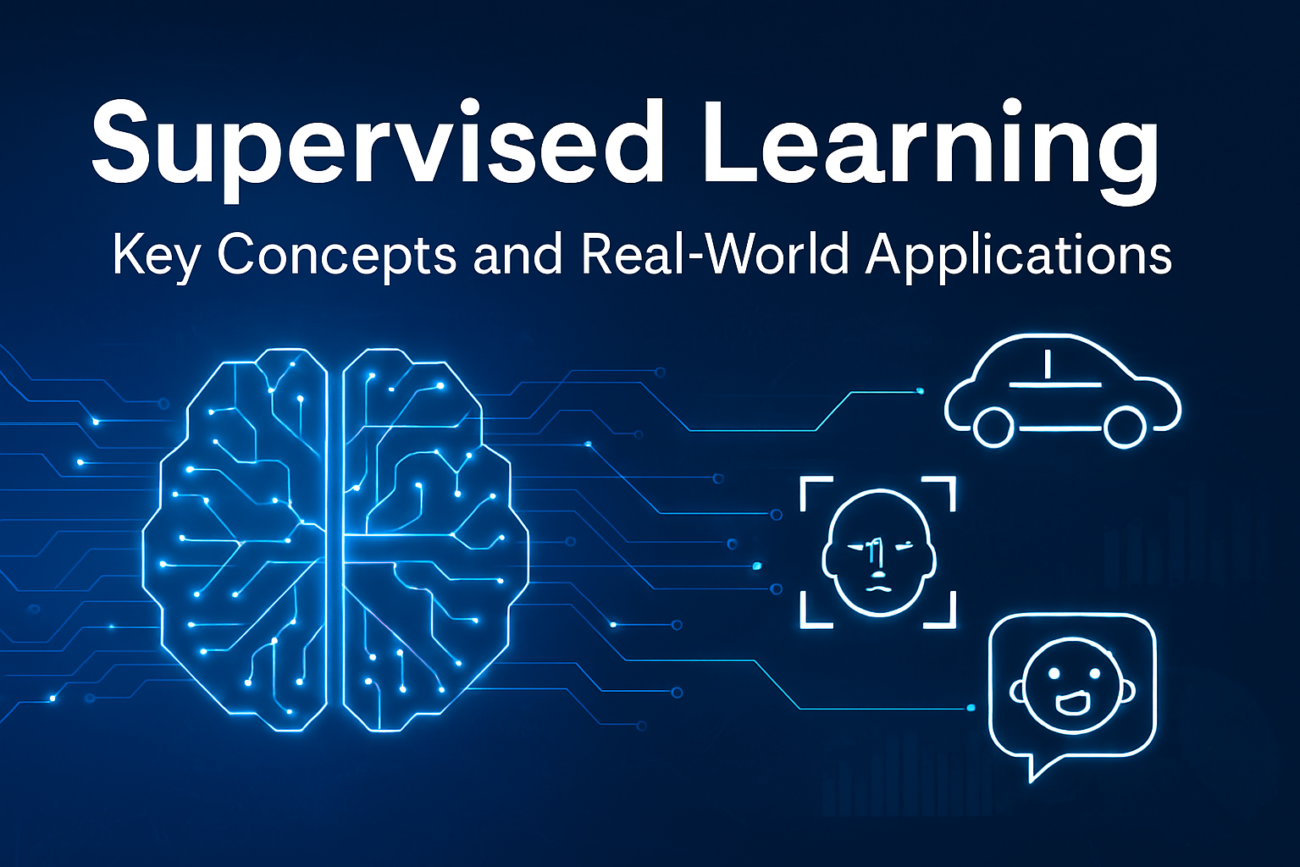An illustration of supervised learning in action, showing labeled data training a machine learning model.
Imagine you’re teaching a child how to recognize different fruits. You show them an apple and say, “This is an apple.” Then, you show them a banana and say, “This is a banana.” Over time, with enough examples, the child learns to identify apples and bananas on their own. This simple process mirrors supervised learning—a machine learning technique where a model learns from labeled examples to make predictions.
In this article, we’ll break down the key concepts behind supervised learning, explore how it works, and uncover its exciting real-world applications. Whether you’re a beginner or looking to refine your understanding, let’s dive in together!
What is Supervised Learning?
Supervised learning is a type of machine learning where an algorithm is trained using a dataset that contains both inputs and their corresponding correct outputs. The goal is for the model to learn patterns from the data so that it can make accurate predictions on new, unseen data (reading more here)
How It Works
Think of supervised learning as a teacher-student relationship:
- The dataset acts as the “teacher,” providing clear instructions.
- The model is the “student,” learning from examples.
- The goal is for the model to generalize what it has learned and apply it to new situations.
This process involves two main steps:
- Training Phase – The model is fed with labeled data (input-output pairs) and adjusts its internal parameters to minimize errors.
- Prediction Phase – Once trained, the model can take new input data and predict the corresponding output.
Example: Predicting House Prices
Imagine you’re a real estate agent trying to predict the price of a house based on features like square footage, number of bedrooms, and location. In a supervised learning approach:
- The input (features) would be house size, number of rooms, location, etc.
- The output (label) would be the actual house price.
- The model learns from past housing data and makes predictions for new houses.
📺 Watch this short video explanation of supervised learning:
Types of Supervised Learning
Supervised learning can be categorized into two main types:
1. Regression (Predicting Continuous Values)
If your goal is to predict a numerical value, you’re dealing with regression. This technique is used for problems where the output is a continuous variable.
🔹 Examples:
- Predicting house prices based on location and size.
- Estimating sales revenue for an e-commerce store.
- Forecasting stock prices.
2. Classification (Categorizing Data)
If you need to assign data into distinct categories, you’re working with classification.
🔹 Examples:
- Spam detection: Classifying emails as spam or not spam.
- Medical diagnosis: Identifying whether a tumor is malignant or benign.
- Facial recognition: Matching a person’s face to their identity.
Real-World Applications of Supervised Learning
Supervised learning is everywhere—often working behind the scenes to make our lives easier. Here are some of its most impactful applications:
1. Fraud Detection in Banking
Banks use supervised learning to detect fraudulent transactions. The model is trained on historical transaction data, learning to distinguish between normal and suspicious activities.
2. Virtual Personal Assistants (Siri, Alexa, Google Assistant)
Supervised learning helps voice assistants understand speech and provide relevant responses. The more you use them, the better they get at predicting what you need.
3. Medical Diagnosis and Disease Prediction
AI models trained on patient data help doctors detect diseases early. For example, supervised learning can analyze X-ray images to identify conditions like pneumonia.
4. Self-Driving Cars
Autonomous vehicles rely on supervised learning to recognize objects like pedestrians, traffic signs, and other vehicles—allowing them to make safe driving decisions.
5. Sentiment Analysis in Social Media
Ever wondered how social media platforms filter out toxic comments? Supervised learning models analyze text data to classify comments as positive, neutral, or negative.
Challenges of Supervised Learning
Despite its many advantages, supervised learning isn’t perfect. Here are some challenges:
🔹 Requires Labeled Data – Gathering and labeling data can be expensive and time-consuming.
🔹 Overfitting – If the model learns too much from training data, it may struggle to generalize to new situations.
🔹 Limited to Known Patterns – Supervised learning can only predict based on what it has seen before, making it less effective for entirely new scenarios.
📷 Infographic: Challenges of Supervised Learning
Final Thoughts
Supervised learning is like a well-trained student—learning from examples and applying that knowledge to new situations. It powers many of the AI-driven applications we rely on daily, from personal assistants to fraud detection.
As technology evolves, supervised learning will continue to play a crucial role in making our world smarter and more efficient. Whether you’re a data scientist, a business owner, or just an AI enthusiast, understanding this concept will help you navigate the AI-driven future with confidence.
🚀 Ready to explore more? Dive deeper into machine learning and discover how AI is shaping the world around us!
📌 Further Reading:
